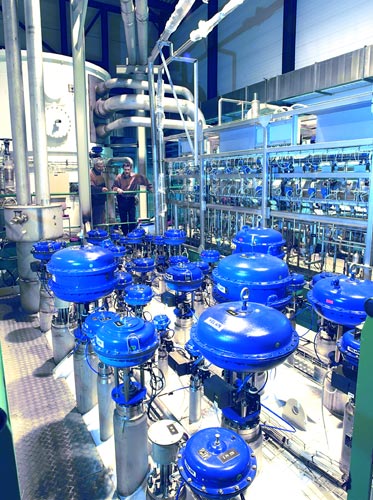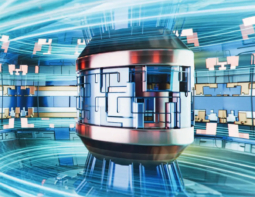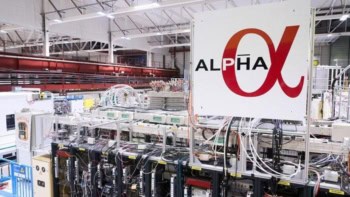Tens of thousands of tonnes of equipment must be cooled to near absolute zero before the Large Hadron Collider can detect its first exotic particle. The head of CERN’s cryogenics group, Laurent Tavian, tells Hamish Johnston how this will be done.

Most particle physicists do not have to worry about how to unload tonnes of liquid nitrogen from trucks arriving at a rate of one per hour for two weeks solid. But that is what CERN’s Laurent Tavian has to look forward to when he begins to cool 37,000 tonnes of equipment for the Large Hadron Collider (LHC), which is scheduled to start up in May 2008. According to Tavian, it will take 10,000 tonnes of liquid nitrogen costing about $1.3m to cool the equipment down to a temperature of about 80 K. Then, liquid helium will take over to chill some parts of the accelerator to temperatures as low as 1.9 K.
And do not think that Tavian will simply be pouring dewars of nitrogen down a pipe into the tunnel that houses the accelerator — nitrogen is banned from the accelerator because when it evaporates, the cold gas tends to accumulate in the tunnel, lowering oxygen levels and thus possibly asphyxiating anyone working there. Instead, the nitrogen will be fed into eight heat exchangers housed above the tunnel that will chill helium gas. This cold gas will then be circulated in a closed system to cool the accelerator from room temperature to about 80 K.
Once this initial cooling phase is complete, Tavian will turn on the LHC’s eight “cryoplants” located in buildings above the accelerator tunnel. The 27 km circumference of the LHC consists of eight sectors each 3.3 km in length. Each sector is served by a cryoplant, in which is housed a helium refrigerator with a cooling power of 18 kW at 4.5 K.
Supercritical helium
The cryogenics for each sector is a closed loop holding a fixed amount of helium that is cooled at the cryoplant and distributed throughout a sector. The warm helium is then captured and returned to be cooled again. While liquid helium could in principle be produced at the cryoplants and then distributed along the length of the sector, this would be tricky because it is so volatile. Instead, the cryoplants will produce high-pressure supercritical helium gas at 4.6 K, which will be distributed along the sector to a number of local cooling loops. There, the supercritical helium will be expanded into a lower-pressure environment, which causes it to liquefy at either 4.5 K or 1.8 K. This liquid will then be used to cool the superconducting magnets.
Working flat out, each cryoplant system can liquefy 4000 litres of helium per hour — more than a litre per second. The entire inventory of helium at the LHC will be about 120 tonnes, which Tavian claims is less than 1% of the total annual helium production worldwide. Even so, it will not come cheap, because helium gas prices have been rising for sometime — at today’s prices the entire inventory is worth over $4m.
Working flat out, each cryoplant system can liquefy 4000 litres of helium per hour — more than a litre per second.
CERN has already taken delivery of about half of the inventory of helium, with the other half arriving between now and April 2008, when the cryogenic system will be turned on. Despite recent rumours suggesting that this delivery target will not be achieved, Tavian says that CERN has signed a new contract with two suppliers — Air Products and the Messer Group — to supply the remaining helium. CERN also has two further suppliers on standby in case Air Products and Messer cannot meet demand.
Different parts of the LHC will be cooled to different temperatures. The thermal shields that surround the coldest parts of the accelerator will be held at temperatures of between 50 K and 75 K. The beam screens, which shield the magnets from the radiation given off by the proton beams, will be kept between 5 K and 20 K. Most of beamline and the superconducting magnets will operate at a chilly 1.9 K using superfluid helium. While the superconducting dipole magnets can function at 4.5 K, Tavian says that it is possible to get an extra 3 T of magnetic field strength out of the devices by cooling them by an additional 2.6 degrees. As a result, the main dipole magnets will be able to deliver a field strength of 8.3 T.
Regular top-ups
Although the helium cryogenics for the LHC is a sealed system, Tavian expects to lose about 25% of the helium inventory every year due to leaks, and regular top-ups will be required to make up the deficit. While this might seem a lot, it is much better than previous CERN accelerators such as the LEP, some of which lost their entire inventory over the course of a year. Tavian thinks that the key to reducing losses is to minimize the amount of helium that is flowing in the closed loop at any given time. In the LHC, two-thirds of the helium will not be flowing but instead will remain stationary in the magnet coldmasses.
Tavian told physicsworld.com that CERN had to initiate the development of two new technologies to create the cryogenics systems. The first is a new compressing system that is capable of generating a large refrigeration capacity at a temperature of 1.9 K — so-called cold compressors. CERN started work on this technology 10 years ago because at the time such compressors were available from only one company and the lack of competition made the equipment very expensive. Thanks to CERN’s efforts, there are now three companies building cold compressors and the price has dropped while performance has improved.
Another important technology developed for the LHC concerns the heat exchangers that remove heat from the very-low-pressure helium between 1.9 K and 4.5 K. When the project was first muted, there were no commercial heat exchangers available, so those used on the LHC were developed by CERN in collaboration with industry. The result is that there are now three companies that are able to design and build sub-cooling heat exchangers, according to Tavian.
Atlas and CMS
In addition to the beamline, two of the four main experiments at the LHC have significant cryogenics requirements: Atlas and CMS. Both experiments use superconductors cooled to 4.5 K to create large magnetic fields and each experiment has its own cryogenics system that is completely separate from that of the accelerator itself. Tavian says that this will allow an experiment to be shut down for repairs without this disrupting the operation of the accelerator or other experiments.
Tavian is also involved in the Global Design Effort (GDE) for the International Linear Collider (ILC) — a next-generation particle-physics experiment that could be up and running by 2019. The cryogenics requirements of the first stage of the ILC will be similar to those of the LHC. The ILC will require 10 cryoplants like the eight used by the LHC. The electrons and positrons in the ILC will be accelerated by superconducting cavities cooled to 2 K using superfluid helium, and therefore the ILC will also need cold compressors. The second stage of the ILC would see the length of the collider double and the number of cryoplants rise to 20.
However, CERN has chosen to scale back its contribution to the ILC design and instead focus on getting the LHC up and running by next May — which is exactly what Tavian will be doing over the coming months.




